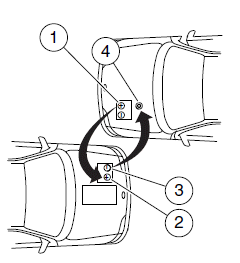Connecting the jumper cables

Note: In the illustration, the vehicle on the bottom is used to designate the assisting (boosting) battery.
1. Connect the positive (+) jumper
cable to the positive (+) terminal of
the discharged battery.
2. Connect the other end of the
positive (+) cable to the positive
(+) terminal of the assisting battery.
3. Connect the negative (-) cable to
the negative (-) terminal of the
assisting battery.
4. Make the final connection of the
negative (-) cable to an exposed
metal part of the stalled vehicle’s
engine, away from the battery and
the carburetor/fuel injection system.

Note: Do not attach the negative (-) cable to fuel lines, engine rocker covers, the intake manifold or electrical components as grounding points.
WARNING: Do not connect the end of the second cable to the negative (-) terminal of the battery to be jumped. A spark may cause an explosion of the gases that surround the battery.
Ensure that the cables are clear of fan blades, belts, moving parts of both engines, or any fuel delivery system parts.
See also:
Fuel filter
Your vehicle is equipped with a lifetime fuel filter that is integrated with
the fuel tank. Regular maintenance or replacement is not needed. ...
Navigation/SYNC system hands-free control features (ifequipped)
Press to active the voice
recognition feature. Refer to Voice
recognition feature in the MyFord
Touch™ / MyLincoln Touch™
supplement.
Press to access phone features.
Refer to Phone f ...
Overview
Lincoln MKT full-size crossover offers a dramatically improved ride, sharper
handling, better fuel economy and new safety technologies including rear
inflatable seat belts for the 2013 model year, p ...
